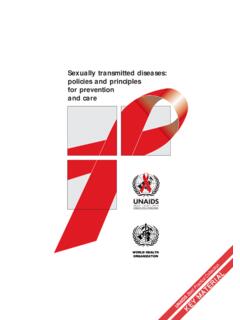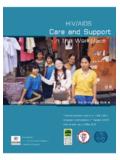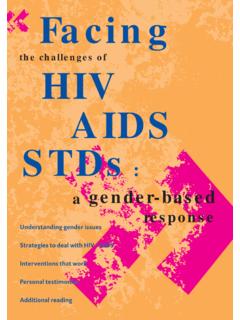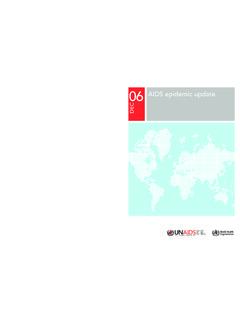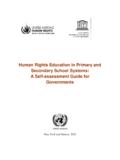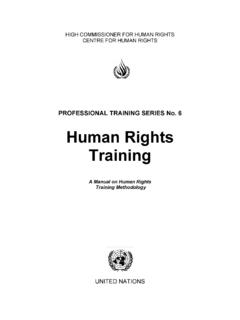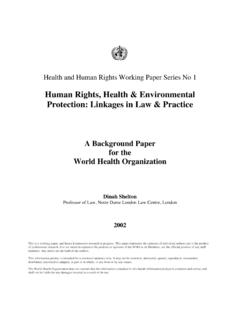Transcription of HIV - Related Stigma, Discrimination and Human …
1 HIV - Related Stigma, Discrimination and Human rights Violations Case studies of successful programmes UNAIDS BEST PRACTICE COLLECTIONthe legal status of any country, territory, city or area or of its authorities, or concerning the delimitation of its frontiers or boundaries. The mention of specific companies or of certain manufacturers products does not imply that they are endorsed or recommended by UNAIDS in preference to others of a similar nature that are not mentioned. Errors and omissions excepted, the names of proprietary products are distinguished by initial capital does not warrant that the information contained in this publication is complete and correct and shall not be liable for any damages incurred as a result of its 20 avenue Appia 1211 Geneva 27 SwitzerlandTelephone: (+41) 22 791 36 66 Fax: (+41) 22 791 41 87E-mail: Internet: (English original, April 2005) ISBN 92 9 173344 X Joint United Nations Programme on HIV/AIDS (UNAIDS) rights reserved.
2 Publications produced by UNAIDS can be obtained from the UNAIDS Information Centre. Requests for permission to reproduce or translate UNAIDS publications whether for sale or for noncom- mercial distribution should also be addressed to the Information Centre at the address below, or by fax, at +41 22 791 4187, or e-mail: The designations employed and the presentation of the material in this publication do not imply the expression of any opinion whatsoever on the part of UNAIDS concerning WHO Library Cataloguing-in-Publication stigma, Discrimination and Human rights violations : case studies of successful programmes.
3 (UNAIDS best practice collection) infections - psychology immunodeficiency syndrome - psychology alienation rights reports ISBN 92 9 173344 X (NLM classification: WC )Cover photos UNAIDS/PANOS and for UNAIDSbyPeter Aggleton, Kate Wood and Anne MalcolmThomas Coram Research Unit,Institute of Education, University of London, United KingdomRichard ParkerDepartment of Sociomedical Sciences, Mailman School of Public Health,Columbia University, New York, United States of AmericaHIV- Related Stigma, Discrimination and Human rights Violations Case studies of successful programmes UNAIDS BEST PRACTICE COLLECTIONUNAIDS2 Table of contentsBackground 4 Understanding stigma and Discrimination .
4 Forms and contexts 7 Stigma, Discrimination and Human rights : an intimate connection 11 Working for success 13 Case studies 14 Stigma-reduction approaches 17 Approach: Improving the quality of life for people living with HIV through integrated care 17 AIDS Integrated Programme, Catholic Diocese of Ndola, Zambia 17 Joint Ministry of Health/NGO home-care programme for people with HIV/AIDS in Cambodia 21 Approach: Mobilizing religious leaders to foster respect and compassion for people living with HIV and AIDS, and to participate in prevention activities 23 Sangha Metta project, Thailand 23 Catholic AIDS Action, Namibia 27 Approach: Providing comprehensive community-based AIDS treatment, including access to antiretroviral therapy 29 HIV Equity Initiative, Haiti 29 Approach: Empowering people living with HIV to take the lead in diverse support and advocacy activities 33 Involvement of people living with HIV in HIV-prevention activities, Belarus.
5 33 Approach: Counselling and support to HIV-affected families, including children, through succession planning 35 Succession planning, Uganda 35 Approach: Addressing broader inequalities through participatory education 39 Centre for the Study of AIDS (CSA) at the University of Pretoria, South Africa 39 Approach: Mobilizing community leaders to encourage greater openness around sexuality- and HIV- Related issues within communities by building on positive social norms 42 Zambia Integrated Health Programme (ZIHP), Zambia 42 Approach: Raising awareness through the media 45 Soul City, South Africa 45 Antidiscrimination measures 48 Approach: Mobilizing the private sector to implement non-discriminatory AIDS policies and promote understanding about AIDS 48 Thailand Business Coalition on AIDS (TBCA), Thailand 48 Approach: Improving employee quality of life through access to integrated care and the implementation of non-discriminatory policies 51 Volkswagen (VW) Brazil 51 Approach.
6 Improving clinical care for patients living with HIV through participatory activities with health-care managers and providers 53 Improving the hospital environment for HIV-positive clients in India 53 Human rights and legal approaches 57 Approach: Promoting the Human rights of people living with HIV and providing redress for violations of their Human rights 57 Acci n Ciudadana Contra el Sida: Citizens Action against AIDS (ACCSI), Venezuela 57 AIDS Law Unit, Legal Assistance Centre, Namibia 61 HIV/AIDS Unit, Lawyers Collective, India 63 Approach: Advocating increased access to HIV treatment 65 Treatment Action Campaign (TAC), South Africa 65 Discussion 68 Conclusions 75 UNAIDS4 Background From the start of the AIDS epidemic, stigma and Discrimination have fuelled the trans-mission of HIV and have greatly increased the negative impact associated with the epidemic.
7 HIV- Related stigma and Discrimination continue to be manifest in every country and region of the world, creating major barriers to preventing further infection, alleviating impact and providing adequate care, support and stigma associated with AIDS has silenced open discussion, both of its causes and of appropriate responses. Visibility and openness about AIDS are prerequisites for the successful mobilization of government, communities and individuals to respond to the epidemic. Concealment encourages denial that there is a problem and delays urgent action. It causes people living with HIV to be seen as a problem , rather than as a solution to containing and managing the epidemic.
8 Stigmatization associated with AIDS is underpinned by many factors, including lack of understanding of the illness, misconceptions about how HIV is transmitted, lack of access to treatment, irresponsible media reporting on the epidemic, the incurability of AIDS, and prejudice and fears relating to a number of socially sensitive issues including sexuality, disease and death, and drug use. Stigma can lead to Discrimination and other violations of Human rights which affect the well-being of people living with HIV in fundamental ways. In countries all over the world, there are well-documented cases of people living with HIV being denied the right to health-care, work, education, and freedom of movement, among others.
9 Global consensus on the importance of tackling AIDS- Related stigma and discrimina-tion is highlighted by the Declaration of Commitment adopted by the United Nations General Assembly Special Session on HIV/AIDS in June 20011. The Declaration states that confronting stigma and Discrimination is a prerequisite for effective prevention and care, and reaffirms that Discrimination on the grounds of one s HIV status is a violation of Human rights . Not only is HIV- Related Discrimination a Human rights violation, but it is also necessary to address such Discrimination and stigma in order to achieve public health goals and overcome the epidemic.
10 Responses to HIV and AIDS can be placed along a continuum of prevention, care and treatment, and the negative effects of stigma and Discrimination can be seen on each of these aspects of the response. Ideally, people should be able to seek and receive voluntary and confidential counselling and testing to identify their HIV status without fear of repercussions. Those who test HIV-negative should receive prevention counselling so as to be able to stay negative. Those who test HIV-positive should receive available treatment and care, and prevention counselling to protect others from infection and themselves from reinfection.
